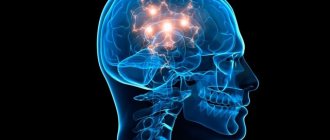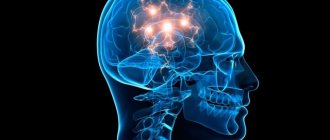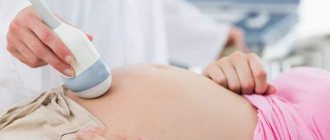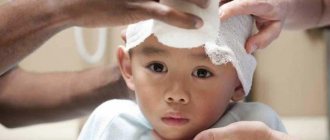What body systems begin to work in a new way?
After conceiving a child, global physiological changes occur in a woman’s body. Great changes are observed in the functioning of the endocrine system. The production of hormones of the anterior pituitary gland, which are responsible for the formation and development of the follicle in the ovary, is suppressed. The corpus luteum is formed - a hormone-producing gland that plays a key role in maintaining pregnancy in the early stages.
A temporary gland forms in the right or left ovary after ovulation and produces progesterone. Functions of progesterone:
- prevents the release of new eggs and the development of menstrual bleeding;
- stimulates the growth of the endometrium, prepares the uterine mucosa for the implantation of the fertilized egg,
- ensures implantation of the embryo and its further normal development;
- promotes the formation of a mucus plug in the cervix, which is necessary to protect the embryo from infections;
- reduces the tone of the muscular layer of the uterus, preventing its contraction and miscarriage.
In non-pregnant women, the corpus luteum dissolves two weeks before menstruation. During the period of bearing a child, it exists until 10-12 weeks of gestation, after which the temporary gland ceases to exist and its functions are performed by the placenta.
The functioning of the corpus luteum is ensured by the hormone hCG, which begins to be produced by chorion tissue 6-8 days after the fusion of male and female gametes. HCG enhances the synthesis of sex hormones and corticosteroids produced in the adrenal cortex.
An important hormone during pregnancy is prolactin, which is produced by the pituitary gland. Starting from the 8th week of pregnancy, prolactin production increases. This is necessary to prepare the mammary glands for breastfeeding, as well as for the normal formation of the lung tissue of the embryo.
In the early stages of pregnancy, the functioning of the thyroid gland changes. The organ increases in size and begins to synthesize more hormones that are important for the development of the embryo.
The immune system
During the period of bearing a child, even in an absolutely healthy woman, the body's defenses decrease. This is due to changes in hormonal levels and the body’s adaptation to new conditions.
The likelihood of acute inflammatory processes and exacerbation of chronic diseases increases. Pathologies of the respiratory, digestive, and genitourinary systems may worsen. The situation is often complicated by the fact that many preventive and therapeutic medications are contraindicated during pregnancy.
What can a pregnant woman do to strengthen her immune system?
- Create a useful menu. Fresh vegetables and fruits, dairy products, fish, nuts, green tea - all this strengthens the immune system.
- Lead an active lifestyle and monitor your body weight. Excess weight and inactivity reduce the body's defenses.
- Avoid stress. Emotional experiences suppress the functioning of the immune system.
In addition, during pregnancy it is important to treat any inflammatory processes in a timely manner. All body systems are interconnected. For example, a common cold can cause acute pyelonephritis or other serious illness.
Psycho-emotional changes
Almost all women during pregnancy are subject to sudden emotional changes, because changes in hormonal levels affect the functioning of the central nervous system. The psycho-emotional state of a pregnant woman often worsens during toxicosis. In this regard, a pregnant woman may experience:
- tearfulness;
- irritability;
- dizziness;
- drowsiness.
As a rule, such manifestations are characteristic only of early pregnancy. Good sleep, moderate physical activity, pleasant activities and hobbies will help you cope with emotional stress in the first trimester.
Online consultation with a gynecologist
Online consultation
During the consultation, you will be able to voice your problem, the doctor will clarify the situation, interpret the tests, answer your questions and give the necessary recommendations.
Fetal development by week in the first trimester
The conception of a child occurs during the period of ovulation, after the fertilization of the egg by the sperm. As a rule, ovulation coincides with days 10-16 of the menstrual cycle.
Human intrauterine development is divided into two stages: embryonic and fetal. The first stage is the period from the moment of fertilization of the egg to the tenth week of pregnancy.
During the embryonic stage, important processes occur: crushing and implantation of the embryo into the uterine cavity, the formation of the neural plate (the rudiment of the central nervous system) and its closure into the neural tube, the formation of organs and the placenta.
It is worth distinguishing between embryonic and obstetric stages of pregnancy. The first is counted from the moment of conception, the second - from the beginning of the last menstruation. As a rule, the difference between these periods is two weeks.
It turns out that the formation and ontogenesis of the embryo begins only in the third week of pregnancy. Let's take a closer look at how the fetus develops week by week during the first trimester.
3rd week of gestation
After the sperm penetrates the egg, a zygote is formed - a diploid cell with a set of chromosomes equally obtained from female and male gametes. The duration of formation of a diploid cell is 25-30 hours.
The zygote begins dividing and moving towards the uterus. At the beginning of division, the zygote splits into 2-4 blastomeres (round-shaped cells that form the embryo). The number of blastomeres increases every day.
On the fourth day after conception, the zygote consists of 12-14 blastomeres. The density of embryonic cells increases, and they are closely connected with each other. The embryo enters the uterine cavity.
A blastocyst is formed (an early stage of embryo development), which is implanted into the endometrium of the uterus. During implantation, a pregnant woman may experience uterine contractions and spotting, which is often mistaken for menstruation. However, unlike menstruation, bleeding during implantation is mild and short-lived.
4 week
Implantation accelerates the development of the embryoblast (internal cells of the embryo), resulting in the formation of extra-embryonic organs:
- chorion is a membrane that performs excretory, respiratory and protective functions. After implantation of the embryo, the first chorionic villi begin to appear on its surface. Subsequently, some of the chorion cells destroy the uterine wall and participate in the formation of the placenta;
- amnion is a water membrane that provides the fetus with optimal development conditions and protects it from mechanical stress. Amnion fluid consists of proteins, sugars, mineral salts and other substances;
- the yolk sac, which performs a hematopoietic function. At first, its size exceeds the size of the embryo. After the 12th week of gestation, this temporary organ decreases in size and completely disappears.
The formation of the primary intestine occurs. The organs of the digestive system will subsequently develop from its departments. In the fourth week of gestation, the formation of the liver and pancreas occurs.
After implantation of the embryo into the uterine cavity, placenta rudiments form at the site of attachment of the embryo. The process of its formation will be completed by the 16th week of gestation. The placenta provides the fetus with the necessary oxygen and nutrients, protects against infections, and removes metabolic products.
By the end of the fourth week of gestation, a woman notices that the expected menstruation does not occur. During this period, mood swings, fatigue, and increased sensitivity of the mammary glands may occur.
5 week
By the fifth week, the neural tube appears - the basis of the spinal cord and brain. The heart forms from the bulge in the central part of the fruit. During this same period, hemoglobin begins to form, so the rate of iron consumption by the embryo increases.
The umbilical cord begins to form, which will become the connecting link between the embryo and the placenta. As the fetus grows, the umbilical cord also increases in size.
During this period, a woman may experience the first signs of toxicosis: nausea, vomiting, intolerance to certain foods and odors.
week 6
The embryo’s heart begins to beat, and the thymus gland, which is responsible for immunity, is formed. Formed:
- rudiments of arms and legs;
- cerebral hemispheres;
- eye sockets and ear canals;
- organs of the excretory system.
Vessels are actively growing, blood circulation is established.
week 7
Nerve fibers, esophagus, stomach, and pharynx develop. The embryo develops semblances of hands and primary germ cells. The pancreas begins to produce insulin. The respiratory system is currently represented only by the trachea.
A woman may experience increased signs of toxicosis, so it is important to drink plenty of fluids.
8 week
This period is characterized by the formation of facial features in the embryo, as well as the development of the lower and upper limbs. The retina forms in the eyes, the upper limbs are able to bend at the elbows, and the lower limbs at the knees.
The genitals acquire a characteristic appearance, but this is still not enough to determine the sex of the unborn child.
Week 9
Left and right atria and ventricles appear in the heart. Large blood vessels and endocrine glands develop. The placenta begins to produce hormones. The fingers on the lower and upper extremities are fully formed.
10 week
If the genotype of the embryo contains a gene that initiates the development of the male body, then in the tenth week of gestation the testicles actively develop and they begin to produce the hormone testosterone.
At the same time, the fetus develops the optic nerve, and urine begins to form in the kidneys. The strength of bone tissue increases. The diaphragm forms between the abdominal and thoracic cavities.
11 week
From the 11th week the fetal period of intrauterine development begins. The state of health of most pregnant women stabilizes: the symptoms of toxicosis, irritability, and fatigue disappear.
The fetus has formed the most important organs, the face, and the hemispheres of the brain. Muscle tissue develops. The fetus begins to make movements, but the woman does not feel them yet.
12 week
Taste buds on the tongue are formed. The cerebellum is actively developing - the part of the brain that is responsible for performing targeted movements, their speed and maintaining muscle tone. The rudiments of nails and teeth appear.
The thymus gland is a full-fledged organ in which T-lymphocyte differentiation occurs. The body proportions of the fetus are still incorrect: the head is large, the arms are long, and the legs are short and bent at the knees.
The intestines enlarge and begin to fold into loops. Leukocytes appear in the blood, which protect the body from external and internal pathogenic agents.
The formation of the gonads continues. By the end of the 12-13th week of pregnancy, it becomes possible to determine the sex of the fetus.
Pregnancy. Intrauterine development of the fetus by week.
Pregnancy is a physiological process in which a new organism develops in the uterus as a result of fertilization. Pregnancy lasts on average 40 weeks (10 obstetric months).
In the intrauterine development of a child, two periods are distinguished
:
- Embryonic
(up to 8 weeks of pregnancy inclusive). At this time, the embryo is called an embryo and acquires characteristic human features; - Fetal
(from 9 weeks until birth). At this time, the embryo is called a fetus.
The growth of a child, the formation of its organs and systems occurs naturally during various periods of intrauterine development, which is subject to the genetic code embedded in the germ cells and fixed in the process of human evolution.
Embryo development in the first obstetric month (1-4 weeks)
♦ First week (days 1-7)
Pregnancy begins from the moment of fertilization
- fusion of a mature male cell (sperm) and a female egg. This process usually occurs in the ampullary section of the fallopian tube. After a few hours, the fertilized egg begins to divide exponentially and descends through the fallopian tube into the uterine cavity (this journey takes up to five days).
As a result of division, a multicellular organism is obtained
, which is similar to the blackberry (in Latin "morus"), which is why the embryo at this stage is called
morula
. Approximately on the 7th day, the morula penetrates the uterine wall (implantation). The villi of the outer cells of the embryo connect with the blood vessels of the uterus, and subsequently the placenta is formed from them. Other outer morula cells give rise to the development of the umbilical cord and membranes. Over time, various tissues and organs of the fetus will develop from the internal cells.
Information At the time of implantation, a woman may have slight bleeding from the genital tract. Such discharge is physiological and does not require treatment.
♦ Second week (8-14 days)
The outer morula cells grow tightly into the lining of the uterus. The embryo begins to form an umbilical cord and placenta
, as well as
the neural tube
, from which the fetal nervous system subsequently develops.
♦ Third week (15-21 days)
The third week of pregnancy is a difficult and important period
.
At this time, important organs and systems
of the fetus begin to form: the rudiments of the respiratory, digestive, circulatory, nervous and excretory systems appear. At the site where the fetal head will soon appear, a wide plate is formed, which will give rise to the brain. On day 21, the baby's heart begins to beat.
♦ Fourth week (22-28 days)
The laying of fetal organs continues this week
. The rudiments of the intestines, liver, kidneys and lungs are already present. The heart begins to work more intensely and pumps more and more blood through the circulatory system.
From the beginning of the fourth week, the embryo develops trunk folds
, and
the rudiment of the spine
(notochord) appears.
By day 25, the formation of the neural tube
.
By the end of the week (approximately 27-28 days), the muscular system and spine are formed
, which divides the embryo into two symmetrical halves, both upper and lower limbs.
During this period, the formation of pits on the head
, which will later become the eyes of the fetus.
Development of the embryo in the second obstetric month (5-8 weeks)
♦ Fifth week (29-35 days)
During this period, the embryo weighs about 0.4 grams
,
the length
from the crown to the coccyx is
1.5-2.5 mm.
The formation of the following organs and systems begins
:
- Digestive system
: liver and pancreas; - Respiratory system
: larynx, trachea, lungs; - Circulatory system
; - Reproductive system
: precursors of germ cells are formed; - Sense organs
: the formation of the eyes and inner ear continues; - Nervous system
: the formation of parts of the brain begins.
At this time, a faint umbilical cord appears
. The formation of limbs continues, the first rudiments of nails appear.
The upper lip and nasal cavities are formed on the face
.
♦ Sixth week (36-42 days)
The length of the embryo during this period is about 4-5 mm
.
- In the sixth week, the formation of the placenta
. At this stage, it is just beginning to function; blood circulation between it and the embryo has not yet been formed. - The formation of the brain and its parts
continues . At the sixth week, when performing an encephalogram, it is already possible to record signals from the fetal brain. - The formation of facial muscles
begins . The fetal eyes are already more pronounced and uncovered by eyelids that are just beginning to form. - During this period, the upper limbs begin to change
: they lengthen and the rudiments of hands and fingers appear. The lower limbs still remain in their infancy.
Changes in important organs occur
:
- Heart
. The division into chambers is completed: ventricles and atria; - Urinary system
. Primary kidneys have formed, the development of the ureters begins; - Digestive system
. The formation of sections of the gastrointestinal tract begins: the stomach, small and large intestines. The liver and pancreas had practically completed their development by this period;
♦ Seventh week (43-49 days)
The seventh week is significant in that the formation of the umbilical cord is finally completed and uteroplacental circulation is established.
Now the breathing and nutrition of the fetus will be carried out due to blood circulation through the vessels of the umbilical cord and placenta.
The embryo is still bent in an arched manner; there is a small tail on the pelvic part of the body. The size of the head is at least half of the embryo. The length from the crown to the sacrum by the end of the week grows to 13-15 mm.
Upper limb development continues
. The fingers are visible quite clearly, but their separation from each other has not yet occurred. The child begins to perform spontaneous movements with his hands in response to stimuli.
Well formed eyes
, already covered with eyelids, which protect them from drying out. The child can open his mouth.
The formation of the nasal fold and nose occurs
, two paired elevations are formed on the sides of the head, from which
the auricles will begin to develop.
Intensive development of the brain and its parts continues.
♦ Eighth week (50-56 days)
The body of the embryo begins to straighten, length
from the crown to the coccyx is
15 mm at the beginning of the week and 20-21 mm on the 56th day
.
The formation of important organs and systems continues
: digestive system, heart, lungs, brain, urinary system, reproductive system (boys develop testicles). The hearing organs are developing.
By the end of the eighth week, the baby's face becomes familiar to a person
: the eyes are well defined, covered with eyelids, the nose, the ears, the formation of the lips is ending.
Intensive growth of the head, upper and lower extremities is noted , ossification of the long bones of the arms and legs and the skull develops. The fingers are clearly visible; there is no longer a skin membrane between them.
Additionally, in the eighth week the embryonic period of development ends and the fetal period begins. From this time on, the embryo is called a fetus.
Fetal development in the third obstetric month (9-12 weeks)
♦ Ninth week (57-63 days)
At the beginning of the ninth week, the coccygeal-parietal size
the fetus is about
22 mm, by the end of the week - 31 mm
.
- The blood vessels of the placenta
are , which improves uteroplacental blood flow. - The development of the musculoskeletal system continues
. The process of ossification begins, the joints of the toes and hands are formed. The fetus begins to make active movements and can clench its fingers. The head is lowered, the chin is pressed tightly to the chest. - Changes occur in the cardiovascular system
. The heart beats up to 150 times per minute and pumps blood through its blood vessels. The composition of blood is still very different from the blood of an adult: it consists only of red blood cells. - Further growth and development of the brain
continues and the structures of the cerebellum are formed. - The organs of the endocrine system are intensively developing
, in particular the adrenal glands, which produce important hormones. - The cartilage tissue is improved
: the auricles, the cartilage of the larynx, the formation of vocal cords is underway.
♦ Tenth week (64-70 days)
By the end of the tenth week, the length of the fetus
from the coccyx to the crown is
35-40 mm.
- The buttocks begin to develop
, and the previously existing tail disappears. The fetus is in the uterus in a fairly free position in a semi-bent state. - The development of the nervous system continues
. Now the fetus performs not only chaotic movements, but also reflex ones in response to a stimulus. When accidentally touching the walls of the uterus, the child makes movements in response: turns his head, bends or straightens his arms and legs, and pushes to the side. The size of the fetus is still very small, and the woman cannot yet feel these movements. - A sucking reflex is formed
, the child begins reflex movements with his lips. - The development of the diaphragm is completed
, which will take an active part in breathing.
♦ Eleventh week (71-77 days)
By the end of this week, the coccygeal-parietal size
the fetus increases to
4-5 cm.
- The fetal body remains disproportionate
: small body, large head, long arms and short legs, bent at all joints and pressed to the stomach. - The placenta has already reached sufficient development
and copes with its functions: it provides oxygen and nutrients to the fetus and removes carbon dioxide and metabolic products. - Further formation of the fetal eyes occurs
: at this time, the iris develops, which will subsequently determine the color of the eyes. The eyes are well developed, half-closed or wide open.
♦ Twelfth week (78-84 days)
Coccygeal-parietal size
the fruit is
50-60 mm.
- are clearly developing according to the female or male type.
- is further improved.
The intestines are elongated and arranged in loops, like those of an adult. Its periodic contractions - peristalsis - begin. The fetus begins to make swallowing movements, swallowing amniotic fluid. - The development and improvement of the fetal nervous system continues
. The brain is small in size, but exactly replicates all the structures of the adult brain. The cerebral hemispheres and other sections are well developed. Reflex movements are improved: the fetus can clench and unclench its fingers into a fist, grabs the thumb and actively sucks it. - In the blood of the fetus,
not only red blood cells are already present, but also the production of white blood cells - leukocytes - begins. - At this time, the child begins to register single respiratory movements.
Before birth, the fetus cannot breathe, its lungs do not function, but it makes rhythmic movements of the chest, imitating breathing. - By the end of the week, the fetus has eyebrows and eyelashes, and the neck is clearly visible.
Fetal development in the fourth obstetric month (13-16 weeks)
♦ Thirteenth week (85-91 days)
Coccygeal-parietal size
by the end of the week it is
70-75 mm.
The proportions of the body begin to change: the upper and lower limbs and torso lengthen, the size of the head is no longer so large in relation to the body.
- Improvement of the digestive and nervous systems continues.
The embryos of baby teeth begin to appear under the upper and lower jaws. - The face is fully formed
, the ears, nose and eyes are clearly visible (the eyelids are completely closed).
♦ Week 14 (92-98 days)
Coccygeal-parietal size
by the end of the fourteenth week it increases
to 8-9 cm
. Body proportions continue to change to more familiar ones. The face has a well-defined forehead, nose, cheeks and chin. The first hair appears on the head (very thin and colorless). The surface of the body is covered with vellus hairs, which retain skin lubrication and thereby perform protective functions.
- The musculoskeletal system of the fetus is improved
. Bones become stronger. Motor activity increases: the fetus can turn over, bend, and make swimming movements. - The development of the kidneys, bladder and ureters is completed
. The kidneys begin to secrete urine, which mixes with the amniotic fluid. - The endocrine system is improved
: pancreatic cells begin to work, producing insulin, and pituitary cells. - Changes in the genital organs appear
. In boys, the prostate gland forms; in girls, the ovaries migrate into the pelvic cavity. At the fourteenth week, with a good sensitive ultrasound machine, it is already possible to determine the sex of the child.
♦ Fifteenth week (99-105 days)
Coccygeal-parietal size of the fetus
is about
10 cm, the weight of the fruit is 70-75 grams.
The head still remains quite large, but the growth of the arms, legs and torso begins to outstrip it.
- The circulatory system is improved
. In the fourth month, a child’s blood type and Rh factor can already be determined. Blood vessels (veins, arteries, capillaries) grow in length and their walls become stronger. - The production of original feces (meconium) begins.
This is due to the ingestion of amniotic fluid, which enters the stomach, then into the intestines and fills it. - Fingers and toes are fully formed
, and an individual pattern appears on them.
♦ Sixteenth week (106-112 days)
The weight of the fetus increases to 100 grams, the coccygeal-parietal size - up to 12 cm.
- By the end of the sixteenth week, the fetus is already fully formed
, it has all the organs and systems. The kidneys are actively working, a small amount of urine is released into the amniotic fluid every hour. - The skin of the fetus is very thin
, subcutaneous fatty tissue is practically absent, so blood vessels are visible through the skin. The skin appears bright red, covered with vellus hairs and grease. Eyebrows and eyelashes are well defined. Nails are formed, but they only cover the edge of the nail phalanx. - Facial muscles are formed
, and the fetus begins to “grimace”: frowning of the eyebrows, a semblance of a smile, are observed.
Fetal development in the fifth obstetric month (17-20 weeks)
♦ Seventeenth week (days 113-119)
The weight of the fetus is 120-150 grams, the coccygeal-parietal size is 14-15 cm.
- The skin remains very thin
, but subcutaneous fat begins to develop under it. The development of baby teeth continues, which are covered with dentin. The embryos of permanent teeth begin to form under them. - A reaction to sound stimuli appears
. From this week we can say for sure that the child began to hear. When strong sharp sounds appear, the fetus begins to actively move. - The position of the fetus changes
. The head is raised and is in an almost vertical position. The arms are bent at the elbow joints, the fingers are clenched into a fist almost all the time. Periodically, the child begins to suck his thumb. - The heartbeat becomes clear
. From now on, the doctor can listen to him using a stethoscope.
♦ Eighteenth week (120-126 days)
The child's weight is about 200 grams, length - up to 20 cm
.
- The formation of sleep and wakefulness begins
. Most of the time the fetus sleeps, movements stop during this time. - At this time, the woman may already begin to feel the baby moving,
especially with repeated pregnancies. The first movements are felt as gentle jolts. A woman may feel more active movements when she is nervous or stressed, which affects the emotional state of the child. At this stage, the norm is about ten episodes of fetal movement per day.
♦ Nineteenth week (127-133 days)
The child’s weight increases to 250-300 grams, body length – to 22-23 cm.
The proportions of the body change: the head lags behind the body in growth, the arms and legs begin to lengthen.
- The movements become more frequent and noticeable
. They can be felt not only by the woman herself, but also by other people by placing their hand on their stomach. Primigravidas at this time can only begin to feel movements. - The endocrine system is being improved
: the pancreas, pituitary gland, adrenal glands, gonads, thyroid and parathyroid glands are actively functioning. - The composition of the blood has changed
: in addition to erythrocytes and leukocytes, there are monocytes and lymphocytes in the blood. The spleen begins to take part in hematopoiesis.
♦ Twentieth week (134-140 days)
Body length increases to 23-25 cm, weight – up to 340 grams.
- The skin of the fetus remains thin
, covered with protective lubricant and vellus hairs, which can remain until birth. Subcutaneous fatty tissue develops intensively. - The eyes are well formed
, and at twenty weeks the blinking reflex begins to appear. - Improved coordination of movement
: the child confidently brings his finger to his mouth and begins to suck it. Facial expressions are pronounced: the fetus may close its eyes, smile, or frown. - This week, all women feel movements
, regardless of the number of pregnancies. Movement activity varies throughout the day. When stimuli appear (loud sounds, stuffy rooms), the child begins to move very violently and actively.
Fetal development in the sixth obstetric month (21-24 weeks)
♦ Twenty-first week (days 141-147)
Body weight grows to 380 grams, fetal length – up to 27 cm
.
- The layer of subcutaneous tissue increases
. The skin of the fetus is wrinkled, with many folds. - Fetal movements become more active
and noticeable. The fetus moves freely in the uterine cavity: it lies head down or buttocks, across the uterus. Can pull on the umbilical cord, push off the walls of the uterus with hands and feet. - Sleep and wakefulness patterns change
. Now the fetus spends less time sleeping (16-20 hours).
♦ Twenty-second week (148-154 days)
At week 22, the size of the fetus increases to 28 cm, weight - up to 450-500 grams.
The size of the head becomes proportional to the body and limbs. The legs are bent almost all the time.
- The fetal spine is fully formed
: it has all the vertebrae, ligaments and joints. The process of strengthening bones continues. - The fetal nervous system is improved
: the brain already contains all the nerve cells (neurons) and has a mass of about 100 grams. The child begins to take an interest in his body: he feels his face, arms, legs, tilts his head, brings his fingers to his mouth. - The size of the heart increases significantly
and the functionality of the cardiovascular system improves.
♦ Twenty-third week (155-161 days)
The length of the fetal body is 28-30 cm, weight is about 500 grams
. Pigment begins to be synthesized in the skin, resulting in the skin becoming bright red. The subcutaneous fatty tissue is still quite thin, as a result the child looks very thin and wrinkled. The lubricant covers the entire skin and is more abundant in the folds of the body (elbow, axillary, inguinal, etc. folds).
- The development of the internal genital organs continues
: in boys - the scrotum, in girls - the ovaries. - The frequency of respiratory movements increases
to 50-60 times per minute. - The swallowing reflex is still well developed
: the child constantly swallows amniotic fluid with particles of protective skin lubricant. The liquid part of the amniotic fluid is absorbed into the blood, leaving a thick green-black substance (meconium) in the intestines. Normally, the bowel should not have a bowel movement until the baby is born. Sometimes swallowing water causes hiccups in the fetus; a woman can feel it in the form of rhythmic movements for several minutes.
♦ Twenty-fourth week (162-168 days)
By the end of this week, the weight of the fetus increases to 600 grams, body length to 30-32 cm.
- The movements become more and more strong and clear
. The fetus takes up almost all the space in the uterus, but can still change position and turn over. Muscles grow rapidly. - By the end of the sixth month, the child has well-developed sense organs.
Vision begins to function. If a bright light hits a woman’s belly, the fetus begins to turn away and closes her eyelids tightly. Hearing is well developed. The fetus determines pleasant and unpleasant sounds for itself and reacts to them differently. When hearing pleasant sounds, the child behaves calmly, his movements become calm and measured. When unpleasant sounds occur, it begins to freeze or, conversely, moves very actively. - An emotional connection is established between mother and child
. If a woman experiences negative emotions (fear, anxiety, melancholy), the child begins to experience similar feelings.
Fetal development in the seventh obstetric month (25-28 weeks)
♦ Twenty-fifth week (169-175 days)
The length of the fetus is 30-34 cm, body weight increases to 650-700 grams.
The skin becomes elastic, the number and severity of folds decreases due to the accumulation of subcutaneous fatty tissue. The skin remains thin with a large number of capillaries, giving it a red color.
- The face has a familiar appearance to a person
: eyes, eyelids, eyebrows, eyelashes, cheeks, ears are well defined. The cartilage of the ears remains thin and soft, their bends and curls are not fully formed. - Bone marrow develops intensively
, which takes on the main role in hematopoiesis. The strengthening of the fetal bones continues. - Important processes occur in lung maturation
: small elements of lung tissue (alveoli) are formed. Before the baby is born, they are without air and resemble deflated balloons, which straighten out only after the first cry of the newborn. From week 25, the alveoli begin to produce a special substance (surfactant) necessary to maintain their shape.
♦ Twenty-sixth week (176-182 days)
The length of the fruit is about 35 cm, the weight increases to 750-760 grams.
The growth of muscle tissue and subcutaneous fat continues. Bones are strengthened and permanent teeth continue to develop.
- The formation of the genital organs continues
. In boys, the testicles begin to descend into the scrotum (the process lasts 3-4 weeks). In girls, the formation of the external genitalia and vagina is completed. - The senses are improved
. The child develops a sense of smell (smell).
♦ Twenty-seventh week (183-189 days)
Weight increases to 850 grams, body length - up to 37 cm.
- The organs of the endocrine system are actively functioning
, in particular the pancreas, pituitary gland and thyroid gland. - The fetus is quite active
and freely makes various movements inside the uterus. - From the twenty-seventh week, the child begins to develop an individual metabolism.
♦ Twenty-eighth week (190-196 days)
The child’s weight increases to 950 grams, body length – 38 cm.
- By this age, the fetus becomes practically viable
. In the absence of organ pathology, a child with good care and treatment can survive. - Subcutaneous fat continues to accumulate
. The skin is still red in color, the vellus hair begins to gradually fall out, remaining only on the back and shoulders. Eyebrows, eyelashes, and hair on the head become darker. The child begins to open his eyes frequently. The cartilage of the nose and ears remains soft. The nails do not yet reach the edge of the nail phalanx. - This week one of the cerebral hemispheres begins to function more actively.
If the right hemisphere becomes active, then the child becomes left-handed; if the left hemisphere becomes active, then right-handedness develops.
Fetal development in the eighth month (29-32 weeks)
♦ Twenty-ninth week (197-203 days)
The weight of the fetus is about 1200 grams, the height increases to 39 cm.
The baby has already grown enough and takes up almost all the space in the uterus. Movements become less chaotic. The movements manifest themselves in the form of periodic kicks with the legs and arms. The fetus begins to take a definite position in the uterus: head or buttocks down.
All organ systems continue to improve
. The kidneys already secrete up to 500 ml of urine per day. The load on the cardiovascular system increases. The blood circulation of the fetus is still significantly different from the blood circulation of the newborn.
♦ Thirtieth week (204-210 days)
Body weight increases to 1300-1350 grams, height remains approximately the same - about 38-39 cm.
- Subcutaneous fatty tissue constantly accumulates,
skin folds straighten. The child adapts to the lack of space and takes a certain position: curls up, arms and legs crossed. The skin still has a bright color, the amount of grease and vellus hair decreases. - Alveolar development and surfactant production continue
. The lungs prepare for the birth of the baby and the start of breathing. - Brain
development continues , the number of convolutions and the area of the cortex increases.
♦ Thirty-first week (211-217 days)
The child's weight is about 1500-1700 grams, height increases to 40 cm.
- The child's sleep and wakefulness patterns change
. Sleep still takes a long time, during which time there is no motor activity of the fetus. While awake, the child actively moves and pushes. - The eyes are fully formed
. During sleep, the child closes his eyes, while awake, the eyes are open, and the child blinks periodically. The color of the iris is the same for all children (blue), then after birth it begins to change. The fetus reacts to bright light by constricting or dilating the pupil. - The size of the brain increases
. Now its volume is about 25% of the volume of the adult brain.
♦ Thirty-second week (218-224 days)
The child's height is about 42 cm, weight - 1700-1800 grams.
- The accumulation of subcutaneous fatty tissue continues
, and therefore the skin becomes lighter and there are practically no folds left on it. - Internal organs are improved
: the organs of the endocrine system intensively secrete hormones, surfactant accumulates in the lungs. - The fetus produces a special hormone
that promotes the formation of estrogen in the mother's body, as a result of which the mammary glands begin to prepare for milk production.
Fetal development in the ninth month (33-36 weeks)
♦ Thirty-third week (225-231 days)
The weight of the fetus increases to 1900-2000 grams, the height is about 43-44 cm.
- The skin becomes lighter and smoother
, the layer of fatty tissue increases. The vellus hair is increasingly wiped off, and the layer of protective lubricant, on the contrary, increases. Nails grow to the edge of the nail phalanx. - The baby becomes increasingly cramped in the uterine cavity, so his movements become more rare, but strong. The position of the fetus is fixed (head or buttocks down), the likelihood that the child will turn over after this period is extremely small.
- The work of the internal organs is becoming more and more improved
: the mass of the heart is increasing, the formation of the alveoli is almost complete, the tone of the blood vessels is increasing, and the brain is fully formed.
♦ Thirty-fourth week (232-238 days)
The child's weight ranges from 2000 to 2500 grams, height is about 44-45 cm.
- The baby now occupies a stable position in the uterus
. The bones of the skull are soft and mobile thanks to the fontanelles, which can close only a few months after birth. - The hair on the head grows intensively
and takes on a certain color. However, hair color may change after childbirth. - Intensive strengthening of bones is noted
, and therefore the fetus begins to take calcium from the mother’s body (the woman may notice the appearance of cramps at this time). - The child constantly swallows amniotic fluid
, thereby stimulating the gastrointestinal tract and kidney function, which secrete at least 600 ml of clear urine per day.
♦ Thirty-fifth week (239-245 days)
Every day the child gains 25-35 grams. Weight during this period can vary greatly and by the end of the week it is 2200-2700 grams. Height increases to 46 cm.
- All internal organs of the child continue to improve
, preparing the body for the upcoming extrauterine existence. - Fatty tissue is intensively deposited
, the child becomes more well-fed. The amount of vellus hair is greatly reduced. The nails have already reached the tips of the nail phalanges. - A sufficient amount of meconium has already accumulated in the fetal intestines
, which should normally pass 6-7 hours after birth.
♦ Thirty-sixth week (246-252 days)
The weight of a child varies greatly and can range from 2000 to 3000 grams, height - within 46-48 cm
- The fetus already has well-developed subcutaneous fatty tissue
, the skin color becomes light, wrinkles and folds completely disappear. - The child occupies a certain position in the uterus
: more often he lies head down (less often, with his legs or buttocks, in some cases, transversely), his head is bent, his chin is pressed to his chest, his arms and legs are pressed to his body. - The bones of the skull
, unlike other bones, remain soft, with cracks (fontanelles), which will allow the baby's head to be more pliable when passing through the birth canal. - All organs and systems are fully developed for the existence of a child outside the womb.
Fetal development in the tenth obstetric month
♦ Thirty-seventh week (254-259 days)
The child's height increases to 48-49 cm, weight can fluctuate significantly.
The skin has become lighter and thicker, the fat layer increases every day by 14-15 grams per day.
- The cartilage of the nose and ears
becomes denser and more elastic. - fully formed and mature
, the alveoli contain the necessary amount of surfactant for the newborn to breathe. - The maturation of the digestive system has ended
: contractions necessary to push food through (peristalsis) occur in the stomach and intestines.
♦ Thirty-eighth week (260-266 days)
A child's weight and height vary greatly
.
The fetus is fully mature and ready to be born
. Externally, the child looks like a full-term newborn. The skin is light, the fatty tissue is sufficiently developed, and vellus hair is practically absent.
♦ Thirty-ninth week (267-273 days)
As a rule, two weeks before birth the fetus begins to descend
, pressing against the pelvic bones. The child has already reached full maturity. The placenta begins to gradually age and its metabolic processes deteriorate.
- The weight of the fetus increases significantly (30-35 grams per day).
The proportions of the body change completely: the chest and shoulder girdle are well developed, the belly is round, and the limbs are long. - Sense organs are well developed
: the child catches all sounds, sees bright colors, can focus vision, and taste buds are developed.
♦ Fortieth week (274-280 days)
All indicators of fetal development correspond to a newborn . The baby is completely ready for birth. The weight can vary significantly: from 250 to 4000 and above grams.
- The uterus begins to periodically contract
(come to tone), which is manifested by aching pain in the lower abdomen. The cervix opens slightly, and the fetal head is pressed closer to the pelvic cavity. - The bones of the skull are still soft and pliable
, which allows the baby's head to change shape and move more easily through the birth canal.
source https://baby-calendar.ru/plod/razvitie/#ixzz3pltohAiS








